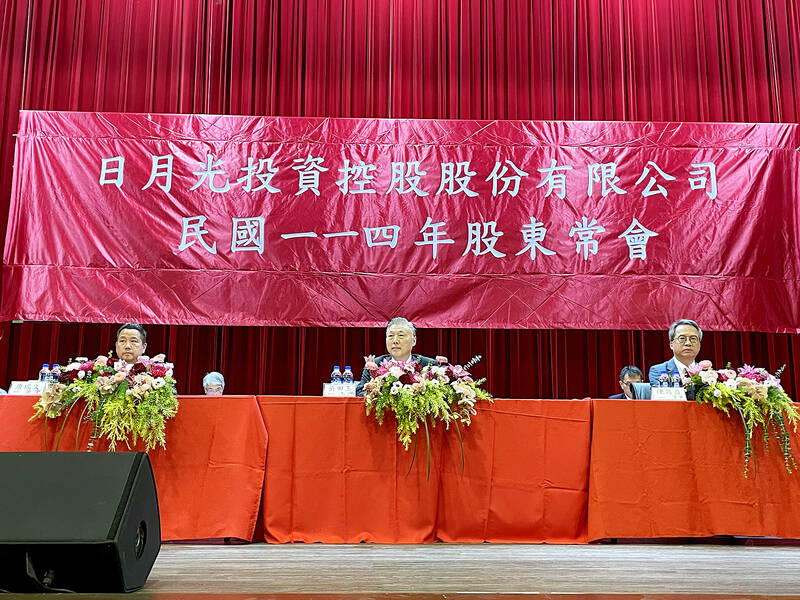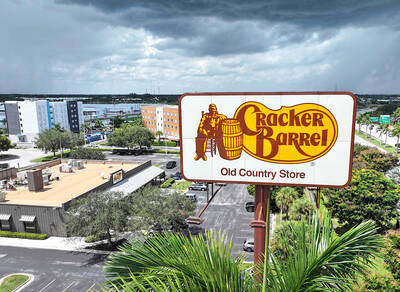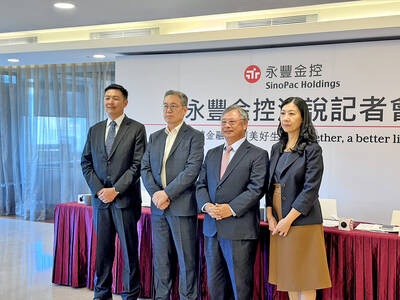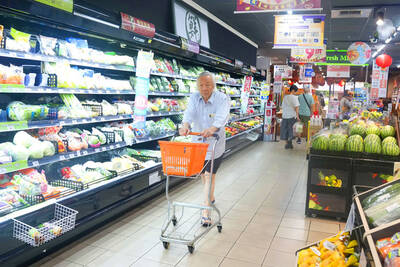ASE Technology Holding Inc (日月光投控), the world’s biggest chip packager and tester, yesterday said it is cautiously evaluating new advanced packaging capacity expansion in the US in response to customers’ requests amid uncertainties about the US’ tariff policy.
Compared with its semiconductor peers, ASE has been relatively prudent about building new capacity in the US. However, the company is adjusting its global manufacturing footprint expansion after US President Donald Trump announced “reciprocal” tariffs in April, and new import duties targeting semiconductors and other items that are vital to national security.
ASE subsidiary Siliconware Precision Industries Co (SPIL, 矽品精密) is participating in Nvidia Corp’s US$500 billion artificial intelligence (AI) infrastructure in Arizona over the next four years, along with other supply chain partners.

Photo: CNA
Nvidia unveiled the investment project in April and SPIL is one of the suppliers of chip-on-wafer-on-substrate (CoWoS) packaging technology for the US company’s AI chips.
Regarding this project, ASE “will proactively plan” capacity expansions, ASE chief operating officer Tien Wu (吳田玉) told a media briefing.
“Other than that, we have also received more requests from customers to build ‘made-in-America’ capacity. We are carefully evaluating this,” Wu said.
Wu said that the US tariff policy did carry weight with ASE’s global manufacturing deployments.
The company is closely monitoring how the tariff landscape is evolving before making any adjustments, he said.
Taiwan is hoping to reduce the 32 percent “reciprocal” tariff proposed by the US before the 90-day reprieve ends early next month.
“Made in America” is viable, but it requires multiple factors to achieve it, including customers’ support and the readiness of employees, Wu said, adding that it would be challenging to duplicate manufacturing technologies in an unfamiliar country.
ASE said it is cautiously optimistic about business prospects for the second half of the year, given rising demand for edge AI devices, application-specific ICs (ASIC) and high-performance computing applications, such as servers and data centers.
The company is sticking to its projected capital spending of US$2.5 billion for this year, up about 32 percent from US$1.9 billion last year.
A big chunk of the budget is earmarked for advanced chip packaging and testing capacity expansions, Wu said.
“It is our feeling that the demand for advanced packaging [technologies] is still in its infancy, as this AI [demand] is just the first wave, which will be followed by a second and third wave,” Wu said.
ASE is confident about AI demand over the next decade, while hardware supply has become the bottleneck now, he said, adding that demand for AI chips is outpacing supply.
To catch this business opportunity, ASE will continue investing in advanced packaging technologies next year, he said.
This year, advanced packaging and testing services revenue would grow at an annual pace of 10 percent, ASE said in its annual report.
ASE shareholders yesterday approved the nomination of Danielle Chang (張淡堯) as a new board director in the by-election, filling the vacancy left by Rutherford Chang (張能傑). Danielle Chang is a daughter of ASE chairman Jason Chang (張虔生).
Shareholders also gave the go-ahead to the distribution of a cash dividend of NT$5.3 per share. That represented a payout ratio of 70.5 percent.

On Tuesday, US President Donald Trump weighed in on a pressing national issue: The rebranding of a restaurant chain. Last week, Cracker Barrel, a Tennessee company whose nationwide locations lean heavily on a cozy, old-timey aesthetic — “rocking chairs on the porch, a warm fire in the hearth, peg games on the table” — announced it was updating its logo. Uncle Herschel, the man who once appeared next to the letters with a barrel, was gone. It sparked ire on the right, with Donald Trump Jr leading a charge against the rebranding: “WTF is wrong with Cracker Barrel?!” Later, Trump Sr weighed

SinoPac Financial Holdings Co (永豐金控) is weighing whether to add a life insurance business to its portfolio, but would tread cautiously after completing three acquisitions in quick succession, president Stanley Chu (朱士廷) said yesterday. “We are carefully considering whether life insurance should play a role in SinoPac’s business map,” Chu told reporters ahead of an earnings conference. “Our priority is to ensure the success of the deals we have already made, even though we are tracking some possible targets.” Local media have reported that Mercuries Life Insurance Co (三商美邦人壽), which is seeking buyers amid financial strains, has invited three financial

OUTLOOK: Among the six sub-indices, only the stock market confidence sub-index rose due to strong equity performance and expectations of a US Federal Reserve rate cut Consumer confidence weakened further this month, sliding to its lowest level in two-and-a-half years as households grew increasingly uneasy about the economic outlook, job security and big-ticket spending, a survey by the National Central University showed yesterday. The consumer confidence index fell 1.07 points from last month to 63.31, the weakest number since May 2023, said the university’s Research Center for Taiwan Economic Development (RCTED), which conducts the monthly poll. “Although the Directorate-General of Budget, Accounting and Statistics recently increased Taiwan’s GDP growth forecast for this year to 4.45 percent, consumer sentiment tells a different story,” RCTED director Dachrahn Wu

Artificial intelligence (AI) chip designer Cambricon Technologies Corp (寒武紀科技) plunged almost 9 percent after warning investors about a doubling in its share price over just a month, a record gain that helped fuel a US$1 trillion Chinese market rally. Cambricon triggered the selloff with a Thursday filing in which it dispelled talk about nonexistent products in the pipeline, reminded investors it labors under US sanctions, and stressed the difficulties of ascending the technology ladder. The Shanghai-listed company’s stock dived by the most since April in early yesterday trading, while the market stood largely unchanged. The litany of warnings underscores growing scrutiny of